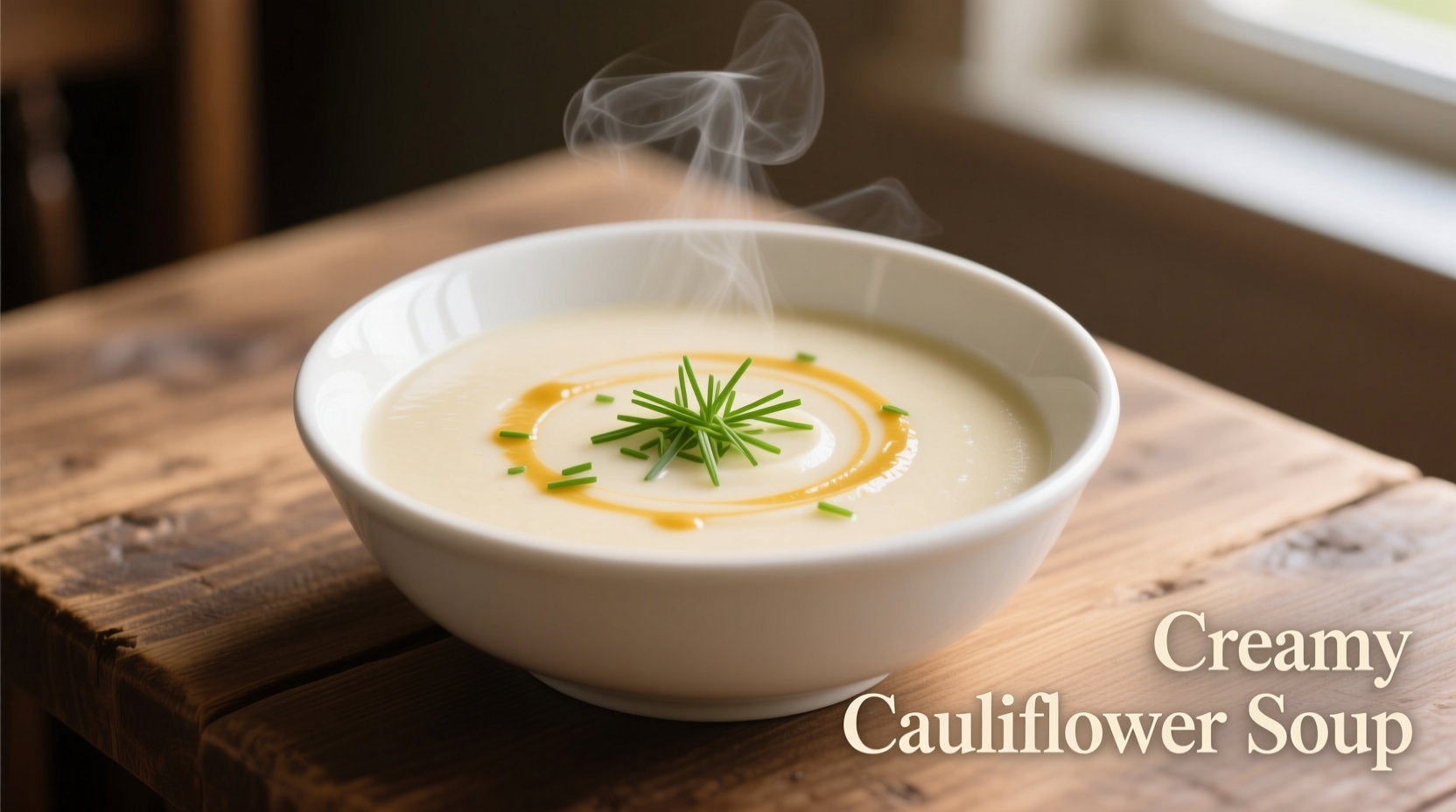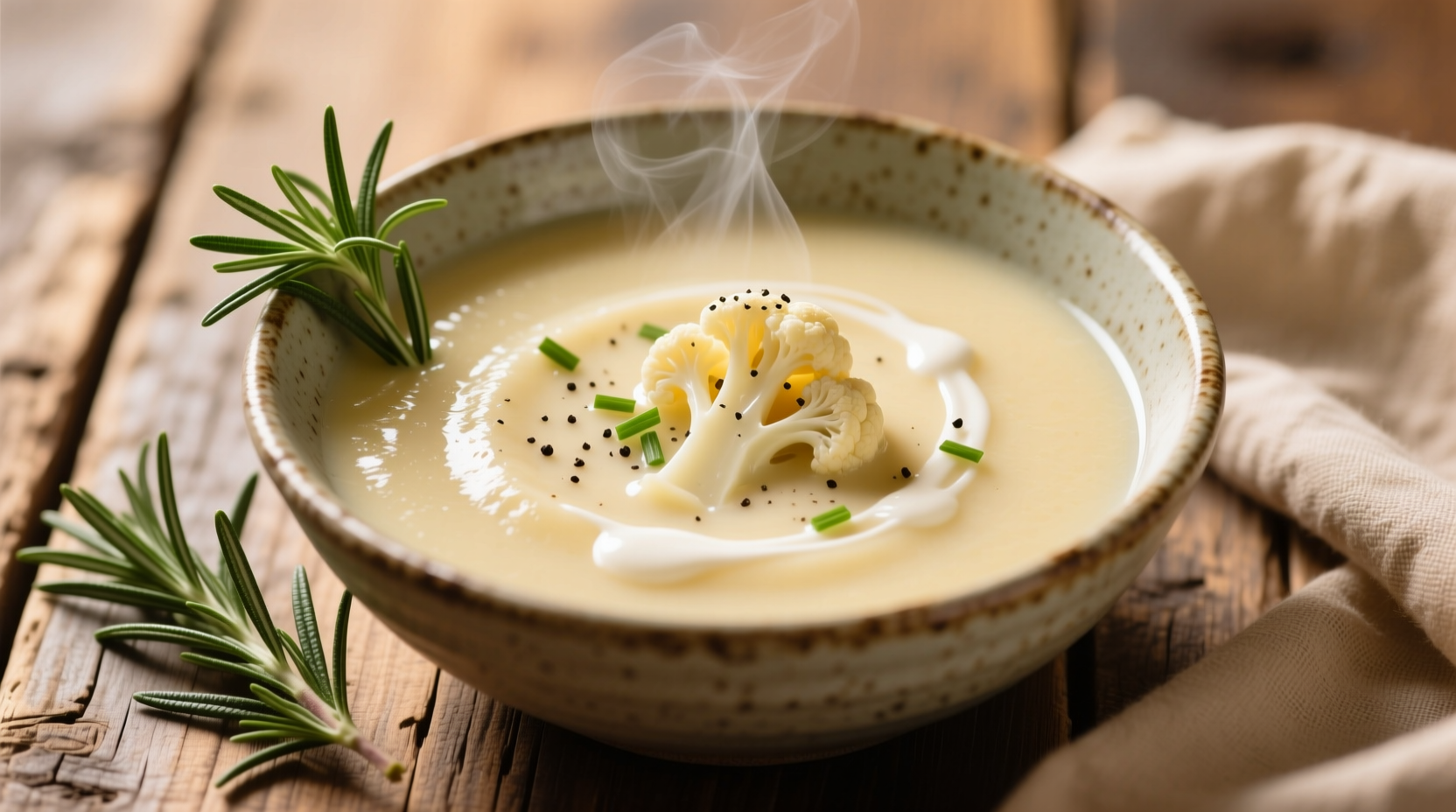Discover how to make a perfectly creamy cauliflower soup using simple ingredients and professional techniques. This guide provides a foolproof recipe with step-by-step instructions, nutritional information, and chef-approved variations for dietary needs. You'll learn why cauliflower works exceptionally well as a base, how to achieve restaurant-quality texture without heavy cream, and creative serving suggestions that elevate this humble dish.
The Essential Foundation: Why Cauliflower Makes the Perfect Cream Soup Base
Cauliflower's mild flavor and high water content create an ideal canvas for creamy soups. Unlike starchy vegetables that require additional thickeners, cauliflower naturally breaks down into a velvety puree when cooked properly. Professional chefs favor it for several key reasons:
- Naturally low in calories (only 25 calories per cup raw) while providing satisfying texture
- Contains compounds that create emulsification when blended
- Readily absorbs complementary flavors from herbs and aromatics
- Works beautifully for dairy-free and low-carb adaptations
Ingredient Breakdown: Quality Matters
The magic of cauliflower cream soup happens through careful ingredient selection. Here's what makes each component essential:
| Ingredient | Why It Matters | Quality Indicator |
|---|---|---|
| Fresh cauliflower | Provides natural creaminess without dairy | Compact head, no browning, heavy for size |
| Yellow onion | Creates flavor foundation without overpowering | Firm texture, dry outer skin, no sprouting |
| Fresh garlic | Adds depth without sharpness when cooked properly | Firm cloves, no green sprouts, papery skin |
| Vegetable broth | Carries flavor compounds while keeping soup light | No artificial flavors, low sodium option preferred |
Step-by-Step Preparation: From Raw Ingredients to Restaurant-Quality Soup
Follow this chef-tested method for consistently perfect results:
- Sweat aromatics: Cook diced onion in olive oil over medium-low heat for 8-10 minutes until translucent but not browned
- Add garlic: Stir in minced garlic and cook for 1 minute until fragrant
- Steam cauliflower: Add cauliflower florets and 1/2 cup broth, cover, and steam for 12-15 minutes until fork-tender
- Blend to perfection: Transfer to blender with remaining broth and blend until completely smooth (critical step for creamy texture)
- Season carefully: Add salt, white pepper, and optional nutmeg to taste

Pro Techniques for Flavor Enhancement
Professional kitchens use these methods to elevate basic cauliflower soup:
- Dry roasting: Roast cauliflower at 400°F for 20 minutes before adding to soup for deeper flavor
- Acid balance: Finish with lemon juice or apple cider vinegar to brighten flavors (1-2 tsp per serving)
- Texture contrast: Reserve some roasted cauliflower florets for topping
- Umami boost: Add 1 tsp nutritional yeast for cheesy notes without dairy
Contextual Considerations: When This Soup Shines
Cauliflower cream soup performs exceptionally well in specific scenarios while having limitations in others:
- Ideal as: Light lunch option, elegant starter for dinner parties, recovery meal when ill
- Best served: Within 2 hours of preparation for optimal texture, reheated gently without boiling
- Dietary strengths: Naturally gluten-free, easily made vegan, low FODMAP when modified
- Limitations: Not suitable as sole protein source without additions, texture degrades after multiple reheatings
Nutritional Profile and Dietary Adaptations
One serving (1.5 cups) of basic cauliflower cream soup provides:
- Calories: 120
- Protein: 4g
- Fiber: 3g (12% of daily value)
- Vitamin C: 70% of daily value
- Vitamin K: 15% of daily value
For specific dietary needs:
- Keto version: Add 2 tbsp heavy cream and 1 tbsp butter at the end
- Vegan option: Blend in 1/4 avocado for creaminess
- Higher protein: Stir in 1/2 cup white beans before blending
- Low FODMAP: Replace onion with 1/4 cup chopped green onion tops
Storage and Reheating Best Practices
Proper handling maintains texture and flavor:
- Refrigerate in airtight container for up to 4 days
- Freeze for up to 3 months (thaw overnight in refrigerator)
- Reheat gently over medium-low heat, adding small amounts of broth if needed
- Never boil after initial preparation as this breaks down the emulsion
Frequently Asked Questions
Can I make cauliflower cream soup without a blender?
Yes, though texture will differ. Simmer cauliflower until extremely tender, then mash thoroughly with a potato masher. For smoother results, press through a fine mesh sieve. The soup won't achieve the same velvety texture as blended versions but will still be flavorful.
Why does my cauliflower soup turn out grainy?
Graininess typically occurs when cauliflower hasn't cooked sufficiently or when blending isn't thorough. Ensure cauliflower is fork-tender before blending, and blend for at least 60-90 seconds. Using a high-powered blender helps achieve smooth texture. Adding a small amount of warm broth to the blender first can also improve results.
How can I make my cauliflower soup creamier without adding dairy?
Several dairy-free options enhance creaminess: blend in 1/4 avocado, 2-3 tbsp cooked white beans, or 1/4 cup cooked potatoes. Roasting the cauliflower first also improves texture. For richer mouthfeel, finish with a drizzle of olive oil or a small amount of coconut milk.
What are the best herbs to pair with cauliflower soup?
Thyme, rosemary, and chives work exceptionally well with cauliflower. Add 1 tsp dried thyme or 1 tbsp fresh thyme during cooking. For finishing, chopped chives or a sprinkle of fresh dill adds brightness. A small amount of nutmeg (1/8 tsp) complements cauliflower's natural sweetness.
Can I use frozen cauliflower for cream soup?
Yes, frozen cauliflower works well but requires slight adjustments. Thaw completely and pat dry to remove excess moisture. You may need to reduce added liquid by 1/4 cup since frozen cauliflower releases more water. Cook time remains similar, but check tenderness carefully as frozen cauliflower can cook faster.











 浙公网安备
33010002000092号
浙公网安备
33010002000092号 浙B2-20120091-4
浙B2-20120091-4